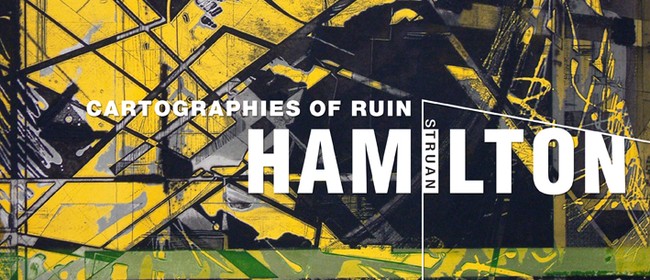Struan Hamilton's exhibition Cartographies of Ruin
will be on display at Saatchi & Saatchi Gallery, 125 The Strand, Parnell
from 11 April to 9 May.
In Evan Calder Williams’ book on salvage punk, Combined and Uneven Apocalypse,
he describes what he calls “the work of construction in the age of wreckage.”
Williams further defines salvagepunk as “the post-apocalyptic vision of a broken and dead world,
strewn with both the dream residues and real junk of the world that was,
and shot through with the hard work of salvaging, repurposing, détourning, and scrapping.
Acts of salvagepunk strive against and away from the ruins on which they cannot help but be built
and through which they rummage.”

In the darkly fretted, complex spaces and textural thickets of Struan’s metal plate etchings
the traditions of British drawing and printmaking,
which relished the linear and textured complexities of factory smokestacks, railway lines,
bare trees in winter, construction-site scaffolds, derricks and dockside cranes in grimy shipyards,
gnarly whorled wharf timbers, ladders, corded masts, stitched sails, and nautical halyards—
are all present as pictorial memory traces.
And this graphic romanticism of skeletal structure and patinated surface
is reborn in Struan’s work through a dark amalgam
with the corrosive nastiness of post-industrial grime and decay.
is reborn in Struan’s work through a dark amalgam
with the corrosive nastiness of post-industrial grime and decay.
There is a heavy metal clamour and dirty glamour;
a post-cubist steampunk brutalism that runs through
the improvisational webs, nets and techno-tangles
of Struan’s acid-etched, scraped, polished, pressed and printed cartographies of ruin.
Discussing his early art school work, Struan talks about drawing a lot of bare trees,
being fascinated by their ‘decay and bleakness;’
of backgrounding figures or objects against jutting, rusty metal surfaces.
He still sees the urban fabric as “all angular, sharp, decaying even;
as buildings go up they look like they are falling apart.”
Struan regards the etching plate itself as a site
on which he pursues parallel processes of making and destroying:
“I love the feeling of working on metal,
there is a kind of decay in the very act of making the etching plate,
the needle lifting away the top ground and the corrosive acid eating the plate...
scraping, burnishing, it's a very physical medium.”
a post-cubist steampunk brutalism that runs through
the improvisational webs, nets and techno-tangles
of Struan’s acid-etched, scraped, polished, pressed and printed cartographies of ruin.
Discussing his early art school work, Struan talks about drawing a lot of bare trees,
being fascinated by their ‘decay and bleakness;’
of backgrounding figures or objects against jutting, rusty metal surfaces.
He still sees the urban fabric as “all angular, sharp, decaying even;
as buildings go up they look like they are falling apart.”
Struan regards the etching plate itself as a site
on which he pursues parallel processes of making and destroying:
“I love the feeling of working on metal,
there is a kind of decay in the very act of making the etching plate,
the needle lifting away the top ground and the corrosive acid eating the plate...
scraping, burnishing, it's a very physical medium.”
[Allan Smith, Elam School of Fine Arts]
Comments